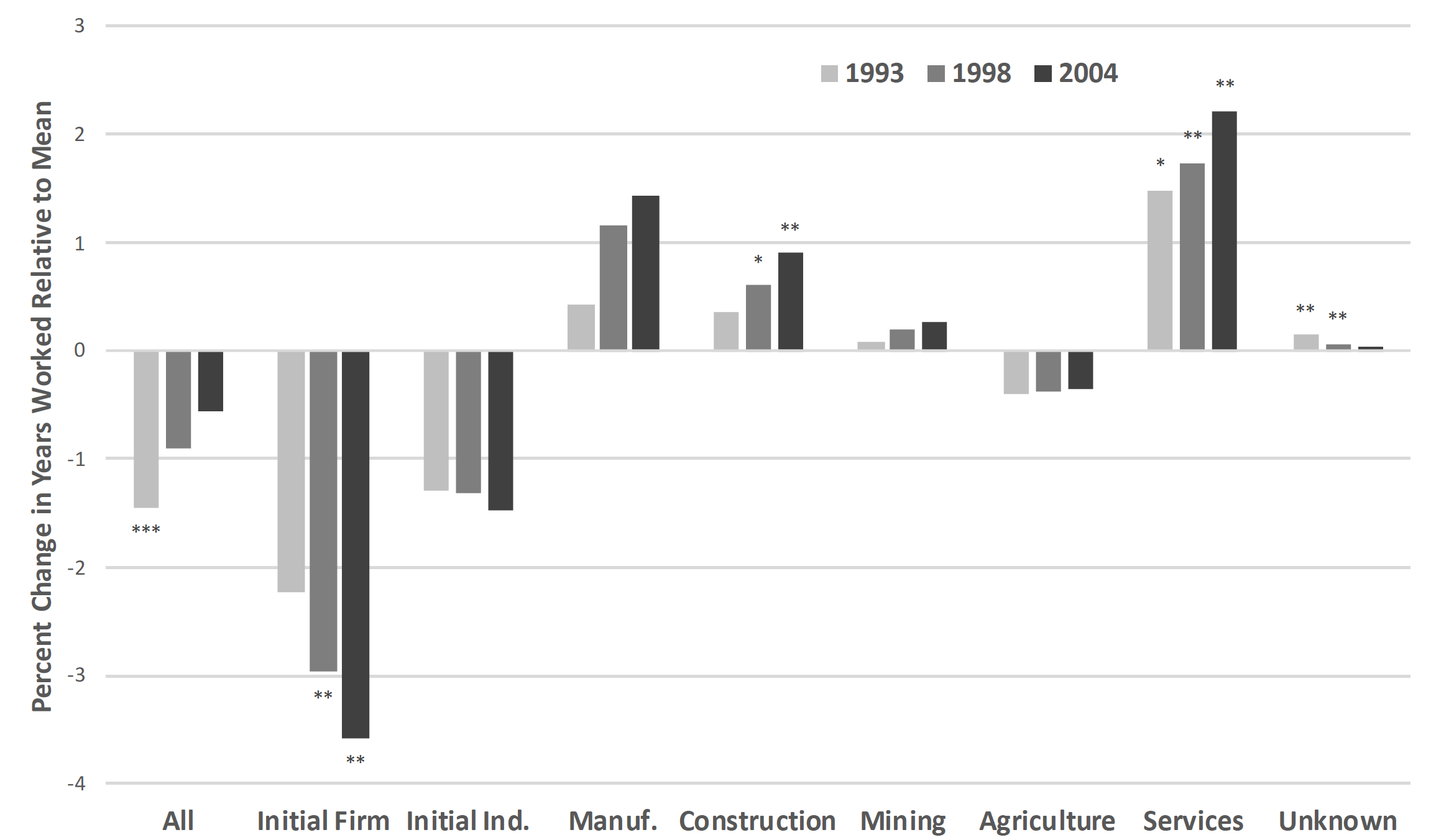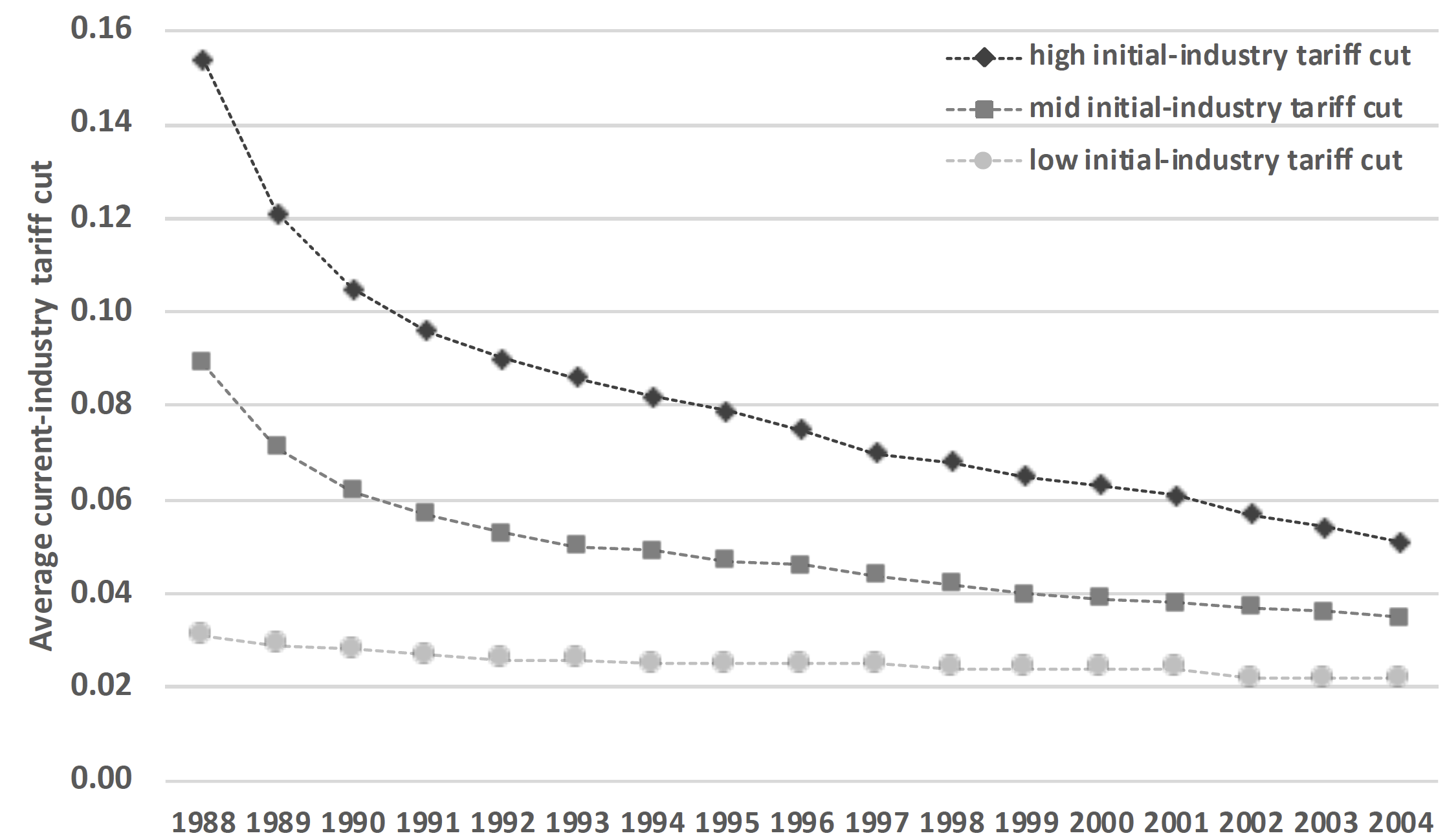While international economists have long studied the distributional consequences of trade liberalisation, traditional approaches assumed full employment and costless worker transitions (Stolper and Samuelson 1941). However, recent empirical findings in Autor et al. (2014), Utar (2014, 2018a, 2018b), Autor (2017), and Dix-Carneiro and Kovak (2017a, 2017b) document persistently depressed labour market outcomes in response to increased import competition. This has led to growing pessimism among both academics and policymakers regarding whether the classic gains from trade are worth the accompanying labour market disruptions.
Given this evidence, one might expect that the 1989 Canada–US Free Trade Agreement (CUSFTA) generated tremendous labour market disruption. This agreement reduced tariffs (taxes on imports) to zero on nearly all non-agricultural trade between the two countries and led to changes in trade flows that were at least as large as those studied in prior research. Yet, in a recent paper (Kovak and Morrow 2022) we find starkly different effects than implied by the previous literature: while Canadian workers suffered short-run displacement and earnings losses in response to increased import competition, long-run labour market outcomes such as years worked and cumulative earnings were largely unaffected. Similarly, Canadian workers in industries that obtained increased access to US markets experienced short-run gains, but these effects had largely disappeared by 2004.
The Canada–US Free Trade Agreement
The negotiations that led to the CUSFTA began in September 1985 with free-market-oriented leaders in both Canada and the US seeking improved market access in the face of slow progress in the multilateral trading system (Morici 1990). Although the Agreement was signed in January 1988, ratification was uncertain in Canada where, like today, trade policy was a politically contentious issue.1 The FTA was the primary issue in the federal election in November 1988, in which Conservatives won enough seats for a majority, leading to the passage of the agreement (Lileeva and Trefler 2010, Sears 2012).
The agreement came into effect in January 1989. Along with cutting non-agricultural tariffs to zero, it harmonised standards, ensured non-discrimination in services regulations, and created a bilateral panel of adjudication to resolve disputes. Although ad-valorem Canadian tariffs on US exports averaged only 8.7% prior to the CUSFTA, tariff reductions led to large increases in Canadian imports from the US. Figure 1 shows that US import penetration as a share of domestic absorption in Canada (the solid line) grew by 40 percentage points from 1988 to 2004. Remarkably, this increase was more than four times larger than the growth in Chinese import penetration in Canada during this period (the dotted line) and much larger than the growth in Chinese import penetration in the US during 1991–2011 (Autor et al. 2014, Table I).2
Figure 1 Change in Canadian import penetration from 1988
Comparing workers facing large vs small reductions in tariff protection
To assess the effect of the FTA tariff cuts on Canadian workers, we ask whether workers facing larger tariff cuts had different post-FTA outcomes than otherwise similar workers facing smaller cuts. Because the tariff cuts were unrelated to pre-FTA industry performance, this approach credibly yields the causal effect of the tariff cuts on workers’ outcomes. In addition, we can use Canadian tax data to follow individual workers over time without the measurement issues raised by the informal sector in other contexts.
Not surprisingly, Canadian workers facing larger Canadian tariff cuts in their initial industry of employment experienced a heightened probability of losing the job they held in 1989. However, there was little impact on total years worked during the 16 years following the FTA’s implementation. Figure 2 documents these effects for low-attachment workers.3
Figure 2 Per cent change in years worked for workers facing large vs small cuts in Canadian tariffs facing US exports
Notes: ‘Initial firm’ is years worked at the initial employer, ‘Initial Ind.’ is years worked at other firms in the same industry, ‘Manuf.’ is years worked in other manufacturing industries, ‘Construction’ is years worked in construction, ‘Agriculture’ is years worked in agriculture, ‘Mining’ is years worked in mining, ‘Services’ is years worked in services, and ‘Unknown’ corresponds to years worked at firms missing a NAICS code.
The figure plots the percent change in years worked for workers facing large (75th percentile) versus small (25th percentile) cuts in Canadian tariffs facing US exports. The dark bars show the full effect through 2004, the final year covered by our sample, while lighter bars show cumulative effects up to earlier years.4 The remaining sets of columns decompose this cumulative effect into years worked in different industries or sectors.
Larger Canadian tariff cuts led to a 3.6% reduction in years worked at the initial firm (approximately five months) but increased the time spent in other manufacturing industries, construction, and services. Because displaced workers were able to find employment in these other industries, the overall effect of import competition on years worked was very small, as were the effects on cumulative earnings during this period.
The FTA not only increased import competition in Canada but also improved Canadian exporters’ access to the US market. In our paper, we show that the effects of US tariff cuts generally mirror those of the Canadian tariff cuts: they reduced a worker’s probability of separating from the initial employer and slightly increased earnings in the short run, with employment and earnings gains in the initial firm partly offset by less time spent employed elsewhere. While all effects are small, workers with stronger labour force attachment tend to be insulated from the negative effects of import competition while still benefiting from increased access to the US market.
How did Canadian workers transition so effectively?
What accounts for the relatively favourable effects experienced by Canadian workers following the CUSFTA relative to those documented by Autor et al. (2014) for the US and Dix-Carneiro and Kovak (2017) for Brazil, each of whom finds large and persistently negative effects of import competition on affected workers? We find three important explanations.
First, Canadian workers quickly transitioned from jobs facing large Canadian tariff cuts and into jobs facing smaller cuts. Figure 3 plots the mean total CUSFTA tariff cut for workers’ industry of employment in each year 1989–2004, dividing all workers into those initially in the most protected industries, those with intermediate initial levels of protection, and those with low initial levels of protection. If no workers switched industries, the lines would be flat. If workers moved into industries with larger Canadian tariff cuts, the lines would be upward sloping.
Figure 3 Average total CUSFTA tariff cut for workers’ industry of employment, 1989–2004
Because the lines are downward sloping, we see that workers moved into industries with smaller tariff cuts, and this happened quickly, particularly for workers initially working in industries facing large tariff cuts. This contrasts sharply with the US experience, as documented by Autor et al. (2014), where manufacturing workers cycled between jobs facing similarly high levels of import competition.
Second, FTA-related import competition did not lead to mass layoffs in which firms substantially cut their workforce. Because mass layoffs lead to persistently negative outcomes for affected workers (Jacobson et al. 1993, Couch and Placzek 2010, Lachowska et al. 2020), the absence of this effect helps explain the relatively favourable outcomes for Canadian workers, consistent with Brandilly et al. (2022).
Third, the negative effects of import competition seem to have fallen most heavily upon new entrants to the labour market. Employment growth was slower for Canadian industries that faced larger tariff cuts. However, more than half of this effect is accounted for by reductions in the inflow of new workers into the industry rather than by job destruction. Since these new entrants were not employed prior to the FTA, they are not included in the main analysis. This finding and those discussed earlier imply that the benefits of liberalisation accrued most strongly to high-attachment workers, while the costs fell mostly on low-attachment workers and new entrants.
Implications
The literature on the labour market effects of trade liberalisation might lead readers to conclude that import competition generally has large and persistently negative effects on affected workers. Our findings on the effects of CUSFTA on Canadian workers are more optimistic. Although the shock we consider was more than four times larger than the China shock and workers experienced a heightened probability of displacement from their initial jobs, they were able to quickly find alternative employment in more favourably affected sectors. Increased export exposure to US markets further smoothed this adjustment. This experience is more in line with the German experience studied by Dauth et al. (2014, 2021) and highlights the diversity of potential responses to trade shocks across different contexts.
References
Autor, D (2017), “Lessons from the China shock”, VoxEU.org.
Autor, D H, D Dorn, G H Hanson and J Song (2014), “Trade adjustment: Worker level evidence”, Quarterly Journal of Economics 129(4): 1799–860.
Brandilly, P, C Hémet and C Malgouyres (2022), “Understanding the reallocation of displaced workers to firms”, VoxEU.org, 2 April.
Dauth, W, S Findeisen and J Suedekum (2014), “The rise of the East and the Far East: German labor markets and trade integration”, Journal of the European Economic Association 12(6): 1643–75.
Dauth, W, S Findeisen and J Suedekum (2021), “Adjusting to globalization in Germany”, Journal of Labor Economics 1(39): 263–302.
Dix-Carneiro, R, and B K Kovak (2017a), “Trade liberalization and regional dynamics”, American Economic Review 107(10): 2908–46.
Dix-Carneiro, R, and B K Kovak (2017b), “Margins of labour market adjustment to trade”, VoxEU.org, 23 August.
Couch, K A, and D W Placzek (2010), “Earnings losses of displaced workers revisited”, American Economic Review 100(1): 572–89.
Forsey, E A (2020), How Canadians govern themselves, 10th edition, Library of Parliament.
Jacobson, L S, R J LaLonde and D G Sullivan (1993), “Earnings losses of displaced workers”, American Economic Review 83(4): 685–709.
Kovak, B K, and P M Morrow (2022), “The long-run labor market effects of the Canada-US Free Trade Agreement”, NBER Working Paper 29793.
Lachowska, M, A Mas and S A Woodbury (2020), “Sources of displaced workers’ long-term earnings losses”, American Economic Review 110(10): 3231–66.
Lileeva, A, and D Trefler (2010), “Improved access to foreign markets raises plant-level productivity…for some plants”, Quarterly Journal of Economics 125(3): 1051–99.
Morici, P (1990), “The environment for free trade”, in Peter Morici (ed.), Making Free Trade Work: The Canada-US Agreement, New York: Council on Foreign Relations.
Sears, R (2012), “The great free-trade election of 1988”, Globe and Mail, 1 October.
Stolper, W F, and P A Samuelson (1941), “Protection and real wages”, Review of Economic Studies 9(1): 58–73.
Utar, H (2014), “When the floodgates open: Northern firms’ response to removal of trade quotas on Chinese goods”, American Economic Journal: Applied Economics 6(4): 226–50.
Utar, H (2018a), “Workers beneath the floodgates: Low-wage import competition and workers’ adjustment”, Review of Economics and Statistics 100(4): 631–47.
Utar, H (2018b), “You are needed but not your skills: Challenges to manufacturing workers in the wake of globalization”, VoxEU.org, 6 December.
Endnotes
1 Although the bill passed the Conservative-led House of Commons, Liberals in the Canadian Senate blocked the bill – something that had not happened to any bill during the preceding 40 years (Forsey 2020).
2 The tariff changes were permanent, eventually being incorporated into the North American Free Trade Agreement (NAFTA).
3 Following ADHS (2014), we define low-attachment workers as those earning less than the equivalent of 1,600 annual hours at the minimum wage in any pre-FTA year, 1985-1988. For context, women and youth are more likely to be low-attachment workers.
4 Effects are prorated by 16/(number of years) so that results do not mechanically increase over time.






